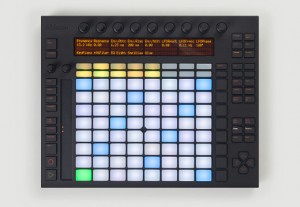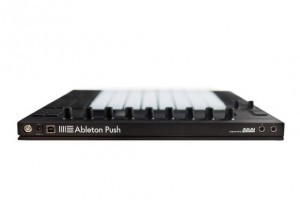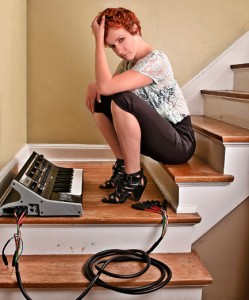Review: Ableton Push Instrument & Controller — By Erin Barra
Ableton’s Push is many things, but at its very essence it’s an instrument that’s been created for the electronic musician. Not to say that it can’t be used by a traditional musician or instrumentalist, but it most definitely is an innovative and hugely powerful weapon on the front lines of the digital music movement.
I feel that a lot of people who engage with new applications make the mistake of letting the technology lead rather than art, which is unfortunate. But pleasantly, I found Push to be a platform that allows you to step away from the computer and play, while still allowing you access to all it’s capabilities.
I have been an avid Live user (no pun intended) for long enough to have become deeply engrained in it’s workflow, and have been an APC 40 user for about three years. Besides that I’m a professional songwriter/producer with a strong and traditional background in piano and theoretical music, so I admit that I was skeptical as to whether or not I was going to be able to “play” Push… at least in the way my mind plays music in.
At it’s core, Push is a USB-powered device with 64 velocity and pressure sensitive pads, eight touch-sensitive encoders, and LCD display. I was pleasantly surprised over and over as to how much sense the whole thing made, how slick and customizable it was to my specific approach.
When I say that Push allows you to play, compose, demo, record, edit, effect, automate and mix, I’m not exaggerating. For being a tool with so much utility, the thing that impressed me the most was it’s simplicity and the amount of thought that went into its creation.
Here’s the push on Push.
Quick Start
First and foremost, it was almost effortless to get going. Push requires no driver or visit to the preferences menu and if you’ve had any experience with other controllers, you can pretty much start making music and getting acquainted directly upon plugging in.
That being said I would say that the chapter on Push in the Live 9 manual is required reading. The physical product comes with very little hard copy information, so you’ll need to head over to Ableton’s site or launch it from the Help menu, for what took me about 10 minutes to read.
Some functionality may seem counter-intuitive at first, but once you dive in it becomes clear that an immense amount of thought and wisdom went into creating this instrument. Some of it can get a little heady at times, but you really can manipulate pretty much every parameter and build an entire Live set without laying a hand on the computer.
Push is Not a Controller
Don’t get me wrong, Push definitely has many of the functions of not only the APC and Novation Launchpad families, but also MPC’s and any polyphonic controller, with a throwback functionality that reminds me of a Texas Instrument Calculator.
You’ll still be able to launch, record, loop, adjust levels, manipulate custom effect racks, etc… so in that sense, Push does act as a controller
Note Mode
• Instrument
In this mode, Push acts as a polyphonic controller where you can actually play melodies and harmonies. This may seem odd considering the unit itself looks nothing like any polyphonic controller you’ve ever seen before, but it’s true.
As a keyboard player I have a very linear approach to playing melodies and harmonies. The default settings of Note mode are setup more like a guitar in terms of the axis’, which is the one I ultimately decided to stick with.
It took a little getting used to and just like any instrument, it requires some practice, but the fact that this portion of the workflow is customizable — I find to be invaluable to the electronic musician who doesn’t necessarily have any specific instrumental proficiency.
Everyone’s mind functions differently and visualizes music in their own way; Push allows you to have it mirror that perception.
• Drum Rack
The setup of the Drum Rack makes so much sense I’m wondering why a controller with just this function didn’t already exist. Whether you like to step sequence to a grid or play your drum patterns live, both options are literally at your fingertips and in front of your face. I was also really impressed with customizable quantization and swing settings, which can be adjusted on the fly for each section directly from the unit. I was able to create patterns that had both precision and personality.
Meters and Tonality
I did attempt to work in a 7/4 and I was pleasantly surprised to find that it worked, even in the step record function, and that I was also able to play in all 7 modes as well as several other ethnic and mathematical scales.
It’s not often you find yourself in A flat Locrian, on stage or in the studio, but Push will most definitely take you there if that’s where you chose to go. I see this functionality as allowing people who necessarily wouldn’t be able to write or play inside of a key center to all of a sudden be able to. Breaking down the barriers of “who can do what” and simply allowing people to create, regardless of skill set, is one of the many things that makes Push so groundbreaking.
Engineering
This is Ableton’s first foray into hardware, and with the help of Akai Professional, the two companies have come together to make something that not only functions like a well-oiled machine but has the luxury touch and feel of a BMW.
The touch sensitivity is to the n’th degree (also customizable) so you’ll literally never miss a beat and the infinity knobs have an almost underwater feel to them. The delete automation function looked so cool that I didn’t expect it to work, but the touch sensitivity is on point. The touch strip brought a very organic vibe to my playing, which I loved. When I successfully executed a trill on the first try, I was totally sold.
My Favorite Thing
My absolute favorite thing about Push is that it forced me to use my ears and allowed me to focus more on the intention of my music rather than the extension of it. Getting away from behind the computer and using Push gave me a new perspective and almost had this totally analog vibe to it.
It’s like the difference between tweaking the parameters of a plug-in and putting your hands directly onto outboard gear.
I’m not sure if Push forced me to depend on my ears more or allowed me to, but I definitely noticed a difference when adjusting audio/MIDI effects. I was hearing more and I think that ultimately made my sessions flow faster and sound better. Sometimes you need to be taken out of your comfort zone in order to grow and Push gives you a new set of eyes and ears.
The other thing I found to be mind-blowing and -bending was that it functions not only left to right and up and down but also in and out, making it three-dimensional. You can dive deep into specific nested layers of parameters and then also pull out to see potentially huge live sets from a bird’s eye view. Creating something that functions in such a micro and macro way is no small feat and my hat goes off to both Ableton and Akai Professional for leaving almost no stone unturned.
Functions I would like to see in the future:
• Rewire
I work in a lot of collaborative settings and attempted to throw Push into the mix with a co-creator. We took turns having one of us being behind the computer while the other one was behind the Push without a huge amount of luck.
Whatever you do on the Push is happening on the computer in real time and vice versa so we were forced to work on the same channel, rather than be able to manipulate separate tracks at the same time. It would be cool to have the option to run Push through a specific channel so that someone could be working on the drum programming while the other was working on a synth pad, or what have you.
• Odd Meters
When I was working in a 7/4 time signature in Note Mode with a Drum Rack at a 1/8 note subdivision, everything was great until I extended the loop section longer than 1 bar. When I went to 2 bars the downbeat of the next measure fell on the next available pad, which in this case was the 15th pad on the right hand side of the unit. (In any 4/4 time signature the downbeat falls on the left-most pad).
I would prefer the downbeat to snap to the next available pad on the left and leave pad 15 and 16 empty.
• Touch Strip
I love the fact that the Touch Strip exists and functions so well not only as a pitch bend, but also to move through banks of sounds. That being said, I wish that I could customize it to work as a mod wheel if I choose or if there was an additional strip for that purpose.
Put Your Hands Together
There were a few other small things, which have workarounds that I’m excited to see evolve as Push matures. But on a scale of 1-10 I give Push a 10 for innovation, a 10 for functionality and a 9 for customization. A big round of applause for everyone over at Ableton and Akai Professional for putting together this amazing piece of technology and always thinking about the user first : )
At an MSRP of $599, I think the unit is priced realistically, especially if you’re taking full advantage of all it’s capabilities. Personally, I would consider Push to be an investment in my studio arsenal and also my creative development. Worth it? Yes. For the faint of heart? No
I feel lucky to have gotten on my hands on a unit since they are currently back ordered through what appears to be July. Join Ableton and me for a special event featuring Push at Tekserve, July 18th in NYC.
ERIN BARRA: Singer/Songwriter/Producer/Multi-Instrumenatlist/Ableton-Enthusiast/Nationally-Touring-Aritst. Also visit her on Facebook or Twitter @erinbarra.
Please note: When you buy products through links on this page, we may earn an affiliate commission.










Ryan
July 16, 2013 at 9:53 am (12 years ago)This is still happening on July 18th? No mention of it on Tekserve’s site.
Ryan
July 16, 2013 at 10:08 am (12 years ago)Nevermind, it is. Tekserve’s calendar is organized weird.
David Weiss
July 16, 2013 at 11:01 am (12 years ago)OK, glad you found it! More details here: http://bit.ly/14RD2xa
Ryan
July 19, 2013 at 8:24 am (12 years ago)The event was awesome and I picked my Push up from Tekserve this morning :D!
Thanks to this!
Nigel Sifantus
July 26, 2013 at 9:47 am (12 years ago)If you are looking for more tips on using the push, specifically on using the drum rack step sequencing on non drum rack midi tracks, we just made a detailed blog post on our Blend.io blog : http://blnd.io/1aA9F8e . This one is specifically on integrating it with Maschine but the technique also works for other midi tracks/VST’s . The secret is the “group to drum rack” option.